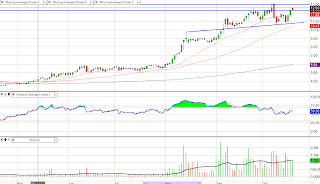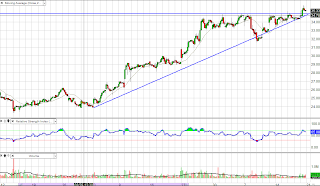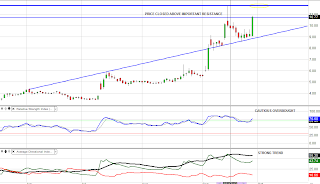Colombia vio crecer su economía de
forma paulatina el pasado año, expandiendo un 4.3 por ciento en el 2013. No
obstante, la 4ta mayor economía de América Latina crecerá de forma notable
durante los próximos cinco años. Esto se debe a las intervenciones por parte de
instituciones públicas y privadas, con la única finalidad de promover el desarrollo
del ámbito comercial y reducir la exclusión social. En otras palabras, el
crecimiento de la economía Colombiana será catalizada principalmente por el
sector de construcción e infraestructura.
No obstante, debe tenerse en cuenta que el peso Colombiano podría verse
afectado por las siguientes causas:
1. Continúa reducción de compra de activos por parte del
Banco de la Reserva Federal de los EE.UU., y posible aumento de la tasa de
interés en el 2015.
2. Crecimiento económico moderado de la Unión Europea y zona
euro; así como el posible Flexibilización Cuantitativa que el Banco Central
Europeo (ECB) llevaría a cabo para combatir el estancamiento económico.
3. Una reducción de la inversión directa extranjera, y retos
que podrían generarse en el nuevo programa de cuarta generación de
concesionales viales (4G).
Colombia es uno de los países con mayor potencial de crecimiento a largo
plazo, no tan solo en la región Latino Americana, pero a nivel mundial. En la
pasada década, el PIB per cápita se ha duplicado, y ha habido un incremento
robusto en la inversión tanto pública como privada. Esto se debe a un incremento
exorbitante en la seguridad interna y la amplia diversificación económica que enriquece
al país. Colombia, miembro de la Alianza del Pacifico (AP), es mayor exportador
de petróleo, oro, café, flores, carbón, entre otros.
Instituciones internacionales se han percatado del gran potencial que tiene
Colombia. La aseguradora Coface ha incluido Colombia dentro de su lista de
países “neo-emergentes”, llamada los PPICS (Perú, Filipinas, Indonesia,
Colombia y Sri Lanka). Por otro lado, The Economist Intelligence Unit, ha listado
su acrónimo de un grupo bastante prometedor, los CIVETS (Colombia, Indonesia,
Vietnam, Egipto, Turquía y Sudáfrica).
‘Boom’ De Infraestructura Reforzará Economía
BMI View: Seguimos siendo optimistas hacia la industria de la
construcción en Colombia en el corto y mediano plazo. Como tal, pronosticamos
un sólido crecimiento real de 8,4% en 2014, cuando esperamos que la
adjudicación de grandes proyectos de infraestructura a realizarse. Este
panorama positivo es apoyado por un mejor ambiente de negocios y un oleoducto
fuerte de proyectos, especialmente en el sector del transporte - que sigue
representando la mayor proporción de proyectos de infraestructura - y el
segmento de infraestructura de energía y servicios públicos. Fuerte crecimiento
en el año 2014 es una continuación de una tendencia
que surgió en el 2013, cuando la industria experimentó un crecimiento estimado
de 10,5%.
Fuente: www.businessmonitor.com (Traducido al Español)
Para una economía incentivar la productividad y el desarrollo económico
sostenido, la inversión en infraestructura es ineludible. En las pasadas
décadas, Colombia ha mostrado una dilación (<1% del PIB) en la inversión de
la misma, en comparación a otras economías emergentes. No obstante, es preciso
resaltar el entorno actual del sector de infraestructura colombiano. La Agencia
Nacional de Infraestructura (ANI) ha planteado una serie de proyectos que suman
un aproximado de US$47bn en un plazo de cinco años. Entre ellos, se encuentra
el programa de Cuarta Generación de
Concesiones Viales (4G), el cual consiste de un total de cuarenta obras y
sobre 8,000km de carretera. Inclusive, la Agencia Nacional de Infraestructura
(ANI) espera que contribuya alrededor de 0.5 puntos porcentuales del
crecimiento del PIB en los próximos cinco años. También para resaltar, el
Consejo Superior de Política Fiscal (Confis), aprobó un total de diez
concesiones viales con un valor de US$12.79bn, pertenecientes al Programa Autopistas para la Prosperidad.
Se espera que el sector de infraestructura en Colombia conlleve más de 3 por
ciento del PIB en los próximos años.
Sector Inmobiliario Crecerá en el 2014
Es evidente que durante el año previo, Colombia se destacó en el sector de
la construcción, creciendo 15.4 por ciento en construcción de edificaciones
residenciales. El sector inmobiliario, el cual proveerá un continuo soporte al desarrollo
del sector en el 2014, es producto del presente auge en la construcción de
Viviendas de Interés Social (VIS). Las VIS están dirigidas a familias de
ingreso medio y medio-bajo.
Adicionalmente, el vigente marco inmobiliario muestra soporte al
crecimiento de otros sectores; en especial el minero, el cual ha visto crecer
la demanda de cemento y petróleo. Sin embargo, uno de los retos que podrían surgir
sería el aumento de los precios de viviendas. Para contrarrestar este evento, debe
haber una mejora en los balances de hogares.
Inclusión Financiera Sigue Siendo Un Desafío
Colombia carece de un sistema financiero inclusivo a nivel nacional. Según
la Encuesta Global de Inclusión Financiera del Banco Mundial (Global Findex),
tan solo un 30 por ciento de la población Colombiana posee algún tipo de cuenta
bancaria. Para incentivar un crecimiento sostenido, las bancas deben promover
sus servicios en áreas rurales y con baja densidad poblacional. También, las
entidades financieras y organismos reguladores deberán crear nuevos canales de
acceso para ampliar la cobertura de servicios bancarios. Esto brindaría
innumerables beneficios tales como: disminuir costos transaccionales, menor uso
de efectivo, reducir corrupción y actividades ilícitas, incrementar la demanda
interna, incitar el ahorro e inversión, etc. La profundización del canal
tecnológico (Internet Banking) debe ser el primero en la lista de promoción
principalmente debido a su accesibilidad.
Por otra parte, es preciso resaltar la presente ley de inclusión financiera
que se viene debatiendo en la Comisión Tercera del Senado. La nueva ley fue
descrita por la agencia de noticias, Colprensa, de tal manera:
“La iniciativa busca la creación de entidades especializadas en pagos,
ahorros y depósitos, que según el ministro de Hacienda, Mauricio Cárdenas,
estarán facultadas para captar depósitos, y no prestarán ni invertirán recursos
del público; sino que éstos deberán ser depositados en el Banco de la
República.”
Perspectiva de
Inversión
Colombia tiene un increíble potencial de crecimiento durante los próximos
cinco años. El desempleo ha reducido substancialmente en la pasada década,
posicionándose alrededor de 8.7 por ciento en el 2013 de una población de 47
millones. La inflación permanece estable, culminando el mes de Abril en 2.51
por ciento; entre la meta del Banco de la Republica (2% - 4%). De igual manera,
el gobierno ha optado medidas para desplazar la violencia interna y el
narcotráfico, moldeando un país más seguro para inversionistas extranjeros. Una
forma sencilla de exponerse directamente a este mercado Andino es tras los
ETFs: $ICOL - $GXG - $COLX. Ambas agencias de calificación, Moody’s y Standard
& Poors, colocaron un grado adecuado en la deuda soberana de la nación: BBB
y BAA3, respectivamente.























































